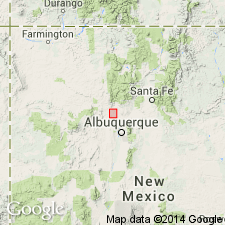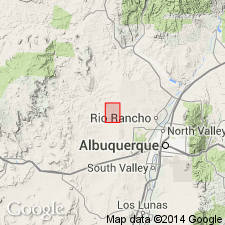
- Usage in publication:
-
- Chamisa Mesa Member
- Modifications:
-
- Original reference
- Dominant lithology:
-
- Sand
- Sandstone
- Clay
- Silt
- AAPG geologic province:
-
- San Juan basin
Summary:
Chamisa Mesa Member of Zia Sand Formation. Name proposed for upper part of Zia Sand. Base of member not exposed in Arroyo Pueblo but is cut off and buried on west end of Arroyo Pueblo fault. About 300 feet of sediments are exposed below Blick quarry. The Jeep quarry occurs about 275 to 300 feet stratigraphically above Blick quarry. The limestone ledge that crops out stratigraphically 75 feet above Jeep quarry horizon contains distinctive mammillary inclusions of silica is here considered the top of the member. Beds overlying the Chamisa Mesa Member are correlated as part of Santa Fe Formation. Overlies Piedra Parada Member (new) of the Zia. Age is early and middle Miocene.
Type section: in sec. 25, T. 16 N., R. 2 E., and in sec. 30, T. 16 N., R. 3 E., Sandoval Co., north-central NM. Section is in Arroyo Pueblo drainage system. Named from Chamisa Mesa, a prominent basalt-capped mesa on the flanks of which a part of the beds of the member crop out.
Source: US geologic names lexicon (USGS Bull. 1350, p. 142).

- Usage in publication:
-
- Chamisa Mesa Member
- Modifications:
-
- Areal extent
- AAPG geologic province:
-
- San Juan basin
Summary:
Chamisa Mesa Member of Zia Sand. Consists of eolian sand that had been stabilized by plants, lacustrine sediments and loess, with alluvial deposits at top. Unconformably underlies Canada Pilares Member (new) and unconformably overlies Piedra Parada Member (both of Zia Sand). Age is early Miocene (Hemingfordian).
Area of report in Sandoval Co., north-central NM.
Source: Modified from GNU records (USGS DDS-6; Denver GNULEX).
- Usage in publication:
-
- Chamisa Mesa Member
- Modifications:
-
- Areal extent
- AAPG geologic province:
-
- San Juan basin
Connell, S.D., Koning, D.J., and Cather, S.M., 1999, Revisions to the stratigraphic nomenclature of the Santa Fe Group, northwestern Albuquerque basin, New Mexico: New Mexico Geological Society Field Conference Guidebook, no. 50, p. 337-354.
Summary:
Pg. 339 (fig. 3), 342. Chamisa Mesa Member of Zia Formation of Santa Fe Group. At Arroyo Ojito the Chamisa Mesa is only somewhat similar to the type section of Galusha (1966). The massive to cross-bedded, greenish-gray silty sandstone and siliceous limestone beds of the type Chamisa Mesa are missing. At Arroyo Ojito it consists of pinkish-tan, well-sorted, massive, very fine- to medium-grained, cross-stratified sandstone that is similar to the medium-grained eolian beds in the [underlying] Piedra Parada Member of Zia Formation. Overlain by Cerro Conejo Member (new) of Zia Formation; contact is gradational and placed at base of lowest reddish-brown, muddy sandstone just below the lowest laterally extensive cliff-forming tabular sandstone. Age is early Miocene (Hemingfordian).
Source: Publication.
For more information, please contact Nancy Stamm, Geologic Names Committee Secretary.
Asterisk (*) indicates published by U.S. Geological Survey authors.
"No current usage" (†) implies that a name has been abandoned or has fallen into disuse. Former usage and, if known, replacement name given in parentheses ( ).
Slash (/) indicates name conflicts with nomenclatural guidelines (CSN, 1933; ACSN, 1961, 1970; NACSN, 1983, 2005, 2021). May be explained within brackets ([ ]).

